Polar Bears
Polar bears are the carnivorous mammals of the Arctic. These snow white creatures spend most of their time on sea ice and prefer swimming mostly to hunt seals, their main source of food. Living in extreme temperatures, polar bears have no human or animal fear or enemies. Since they are on the higher end of the food chain, they are considered one of the deadliest predators alive.
These animals adapt to their fierce cold inhabitation seeking heat from their thick fur and fat layers. Polar bears spend most of their time at the shifting edge of the packed ice during the colder months while some migrate to the land during warmer months.
Scientific Classification
Kingdom | Animalia |
Phylum | Chordata |
Class | Mammalia |
Clade | |
Order |
Species
Unlike most animals, polar bears have no recognized subspecies. They are considered “monotypic” which means that there is only one kind of species of the polar bear.
In the past, polar bears were classified into several subspecies including,
- Ursus maritimus maritimus: This subspecies included the classic polar bear found across the Arctic.
- Ursus maritimus marinus: This species of polar bears specifically adapted to sea life.
- Ursus maritimus tyrannus: Now extinct, these subspecies were larger than the polar bears seen today. After some time they were classified under the species of giant brown bears.
Scientists suggest that polar bears come from the ancestry of the brown bear family around 250,000 years ago also known as their “sister species,” They share several genetic characteristics of the bear family, and ranked sixth in the Ursinae subfamily and eighth in the Ursidae family.
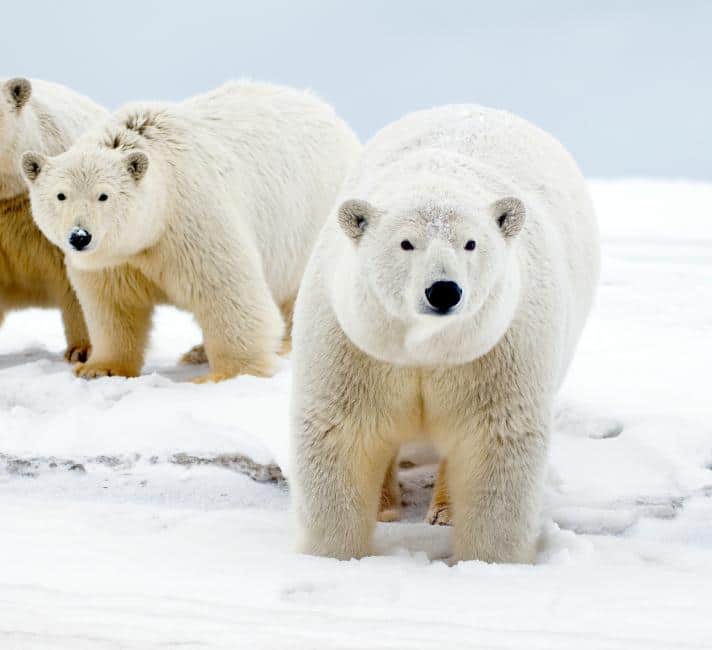
Physical Characteristics
Size and Weight: These massive species and weigh hundreds of kgs because of their fur and fat layers. Adult males on average weigh 350-600 kg and females weigh 150-290 kg. Some big males can weigh as high as 800 kg! While they do have sleek bodies compared to brown bears, they can go over 3 metres tall standing on their back legs.
Body and Tail: They have slender bodies with long necks and small skulls. Their back limbs are longer than their forelimbs which gives them a raised back and slight shoulder hump. Their tail is short, barely 7-13 cm long.
Speed: Polar bears are slow bulky animals that can run up to a speed of 40 kph, but usually they just walk at about 5 kph. In water, their swimming speed is 10 kph; however, the longest recorded swim by a polar bear is 686 kph (426 miles).
Paws: Since polar bears have to walk around on ice and swim through icy waters, they have big-paddle shaped paws that are up to 30 cm wide. Their claws are over 5 cm long and quite sharp to grip and catch their prey.
Fur and Coat Coloration: While they do appear white, their fur is actually translucent which means that they have no color. The skin under this heavy coat of fur is black that allows them to absorb heat and sustain in negative temperatures. This black color can be seen on their nose, lips, and foot pads.
Teeth: Polar bears are dangerous carnivores with 42 teeth. They use the sharp incisors and jagged molars to tear through the meaty prey. They shallow chunks of their food rather than chewing them.
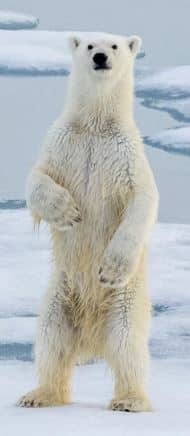
Size and Weight
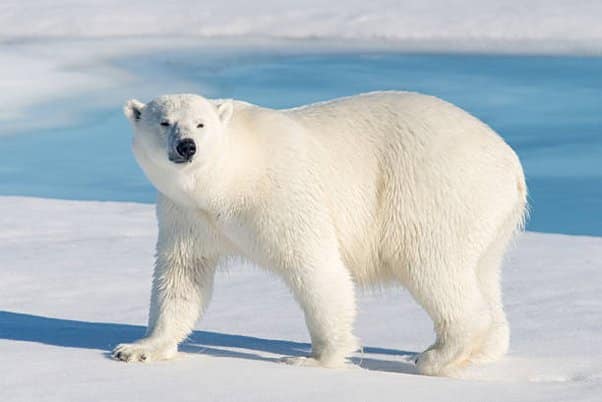
Body and Tail
Where Do Polar Bears Get Their Name From?
The mammals of the Arctic, polar bears are named after the place they live. Polar comes from “Polaris,” which means “of the pole.” The native origin of these animals is the region around the North Pole, hence they are polar animals of the North.
As these bears are connected to the frozen, sea-bound region, their scientific name is Urus maritimus (sea bear).
Distribution and Habitat
The arctic region where polar bears are found spans across five countries, including the U.S (Alaska), Norway (Svalbard), Russia, Canada, and Greenland. Most of their lifetime is spent around the polar ice edges where they rest, raise their offspring and hunt for food.
Although called polar bears, these animals stay close to the continental shelf ane barely go far off north to avoid food scarcity. Some of them stay on a particular piece of land during ice melts and some follow the shifting ice areas throughout the year. Polar bears are also found in the Southern parts such as James Bay, Canada.
Their preferred habitat has two key areas: the leads and polynyas. Leads are water specific areas usually caused by cracking of ice. These are open depending on the temperature and may last a few months. Polynyas is a water basin surrounded by ice that remains open throughout the year. These are polar bears’ favourite spots since they are mostly stable for food hunting.
Diet and Digestion
The main source of food is seals. Polar bears prefer ringed or bearded seals as the best source of food; however, they also feast on walruses, narwhals and beluga whales. During starvation or lack of food, they also eat fish, birds and carcasses but these don’t fulfil their dietary needs.
Polar bears have a strong digestive system. The carnivores rely on high protein and fat, digesting 84% protein and 97% fat from the food source. A 2 kg of fat and protein is required to sustain daily.
Behavioral Adaptations
Social Behavior
Polar bears are silent and solitary animals. They spend most of their lifetime alone and avoid socializing with their own breed. They sometimes form alliances before the mating season to find prospects. Large males are considered superior followed by mothers accompanying cubs.
Hibernation
Unlike most Arctic animals, polar bears do not actually hibernate. Only pregnant females enter a state known as carnivore lethargy which is a condition caused by reduced activity. . They enter this in the fall and remain in it through spring, giving birth and nursing babies without food during this time.
Hunting and Preying
Polar bears adopt the “still hunting” method and wait for their prey to come to the surface of the water. This makes it easier for them to find food while staying in the same spot. They sometimes also follow “stalking” method and use their strong sense of smell to find seals and other animals across the water surface. They can smell their prey from a great distance and break through the ice to catch them.
Communication
The main form of communication between these animals is through vocal sounds, body language or scent marking. Adult males have loud and aggressive growling sounds. Mothers use a chuffing sound to talk to their newborns.
Polar bears communicate less with their fellow bears and prefer to stay silent. During food sharing, they greet each other with a gentle touch on their nose.
Cleanliness
Polar bears love cleanliness. They like to wash themselves by rubbing against the snow to remove dirt and blood. This also increases their body’s heat absorption and keeps their fur well-insulated.
Reproduction and Parenting
Mating: Mating season occurs between March to May where the males find females by following their scent. After mating, the pair stays together for a week, after which time they go their separate ways. The females can breed with multiple male bears each season.
Denning: After separation, the pregnant females bring the fat resevres gathered during summer to enter the maternity den. These dens are made in snow drifts where they can hibernate and grow the embryo.
Birth and Nursing: The cubs are born during the winter months of December and January, weighing less than a kg. The nursing period begins which lasts till April when the mother protects the cubs under their body heat until they become around 10 kgs of weight. They then leave the den and start exploring the sea ice. After two years of age, the mother leaves the cub and goes their separate ways.
Mortality Rate and Lifespan
The average lifespan of polar bears is 20-30 years. However, most of them only survive for 15-18 years. The chances of survival increase once polar bears reach maturity. The cubs often suffer due to food scarcity, harsh weather conditions and male bears’ rage.
Fun fact: The oldest polar bear surviving in the wild was aged 32 years!
Ecological Importance
The polar bear is an apex predator and is important in the ecological balance of the Arctic environment in which it lives. They feed on seals and other marine populations which in turn control marine life.
Polar bears’ health and population reflect on the Arctic ecosystem and provide valuable information on climate changes. This makes them an “indicator species” for humans.
Conservation Status
The IUCN have given polar bears the status of “vulnerable species.” The estimated population of polar bears on earth is between 22,000 to 31,000 animals.
Major threats: climate change, ice melting, commercial activities, conflicts with humans
Polar Bears Fun Facts
- Polar bears can eat over 100 pounds of blubber in one sitting.
- They can detect the presence of prey from as far away as 16 km.
- Only 2% of polar bear hunts succeed.
- There are 20 recognized subpopulations of polar bears.
- Polar bears can easily overheat when they exert too much.
Cultural Value
Polar bears are highly respected by the Intuit people of the Arctic. They consider them culturally and spiritually powerful and as symbols of strength, courage and guidance. Some people even invoke these animals’ spirits to seek protection.
The Inuit mythology includes several stories on polar bears where they are portrayed with human-like qualities such as talking. They incorporate these animals in their art through stone and bone sculptures.
FAQs- Frequently Asked Questions
Q: What is polar bear special about?
A: Polar bears are unique for their ability to thrive in the extreme cold of the Arctic, with thick fur and a layer of fat to keep warm, and their powerful hunting skills, especially for seals.
Q: What are the physical characteristics of a polar bear?
A: Polar bears are massive animals with thick translucent fur, black skin, and large, paddle-like paws for swimming. Adult males can weigh up to 600 kg, and some even reach 800 kg.
Q: How many types of polar bears are there?
A: There is only one species of polar bear, making them monotypic. Historically, scientists proposed subspecies, but they are now classified as a single species.
Q: Why are they called polar bears?
A: They are called polar bears because they live in the polar region near the North Pole. The name “polar” comes from “Polaris,” meaning “of the pole.”
Q: What is the largest bear in the world?
A: The polar bear is the largest bear species in the world, with some males weighing over 800 kg and standing more than 3 meters tall on their hind legs.
Q: What is another name for a polar bear?
A: The scientific name for the polar bear is Ursus maritimus, which means “sea bear” because of their strong connection to the Arctic waters.
Q: What is the name of the famous polar bear?
A: Knut, the polar bear from the Berlin Zoo, became world-famous in the mid-2000s after being raised by zookeepers due to his mother rejecting him.
Q: Which country is known as polar bear?
A: Canada is often associated with polar bears, as it is home to a large portion of the polar bear population, especially in places like Churchill, Manitoba.
Q: What is the scientific name for a polar bear?
A: The scientific name for a polar bear is Ursus maritimus.
Q: What is a female polar bear called?
A: A female polar bear is simply called a sow.
Q: What is a newborn polar bear called?
A: A newborn polar bear is called a cub.
Q: What are few lines about polar bears?
A: Polar bears are carnivorous mammals native to the Arctic. They spend most of their time on sea ice hunting seals and have adapted to living in extreme cold temperatures.
Q: What are the special features of polar bears?
A: Special features include their translucent fur, black skin, and large paws adapted for swimming and walking on ice. Their ability to live in freezing temperatures is remarkable.
Q: What is a polar bear’s diet?
A: Polar bears mainly eat seals, especially ringed and bearded seals. They also occasionally feed on walruses, whales, and scavenged carcasses.
Q: What is the life cycle of a polar bear?
A: Polar bears are born as cubs, stay with their mothers for about two years, and reach maturity around 4-5 years old. They can live up to 30 years in the wild, though many don’t survive beyond 15-18 years.
Q: What is the lifestyle of a polar bear?
A: Polar bears lead solitary lives, spending most of their time hunting, especially in cold regions near the ice edges. They travel long distances to find food and rest between hunts.
Q: Why are polar bears important?
A: Polar bears play a crucial role in maintaining the Arctic ecosystem by regulating the seal population, which in turn affects marine life balance.
Q: How to protect polar bears?
A: Protecting polar bears involves reducing greenhouse gas emissions to slow climate change, protecting their habitats, and reducing human-polar bear conflicts.
Q: What is the biggest threat to polar bears?
A: The biggest threat to polar bears is climate change, which is melting the sea ice they depend on for hunting seals.
Q: What are polar bear weaknesses?
A: Polar bears’ biggest weakness is their reliance on sea ice for hunting, making them vulnerable to changes in their environment caused by global warming.
Q: What is a polar bear’s biggest enemy?
A: Polar bears have no natural predators, but their biggest enemies are environmental threats like climate change and human activity.
Q: Why do we need to protect polar bears?
A: Protecting polar bears is essential for preserving the Arctic ecosystem. Their survival also reflects the health of the environment, making them an indicator species for climate change.
Q: What can polar bears teach us?
A: Polar bears teach us about adaptation and survival in extreme conditions. They also highlight the effects of climate change and the importance of conservation efforts.
Q: Can we really save the polar bears?
A: Yes, with significant efforts to combat climate change, reduce pollution, and preserve their habitat, we can help save polar bears from further decline.
Q: What are the advantages of polar bear survival?
A: Polar bear survival helps maintain balance in the Arctic food chain and ensures the health of marine ecosystems, which benefits the entire environment.
Q: What are 5 facts about polar bears?
A:
Polar bears can swim for hundreds of miles without rest.
They have black skin under their fur to absorb heat.
Only 2% of their hunts are successful.
They are the largest land carnivores.
Polar bears can overheat if they exert too much energy.
Q: What is the ecological role of the polar bear?
A: Polar bears regulate the seal population, which helps maintain a balanced marine ecosystem. Their presence also indicates the health of the Arctic environment.
Q: What is the power of the polar bear?
A: Polar bears are powerful predators with the strength to break through thick ice to catch seals. Their sharp claws, strong jaws, and massive bodies make them formidable hunters.
Q: Why are polar bears special?
A: Polar bears are special because of their incredible adaptations to one of the harshest environments on Earth, their status as apex predators, and their significance in the Arctic ecosystem.
Q: What is the intelligence of a polar bear?
A: Polar bears are highly intelligent, known for their excellent hunting strategies, like “still hunting” by waiting at seal breathing holes and using their sense of smell to track prey over long distances.
Q: What are some interesting facts about bears?
A: Bears, including polar bears, are highly adaptable, can walk on their hind legs, and are excellent swimmers. Polar bears have a keen sense of smell, detecting prey from miles away.
Q: What is the lifespan of a polar bear?
A: In the wild, polar bears typically live between 20 and 30 years, though many don’t survive past 15-18 years due to harsh conditions and food scarcity.
Q: What unique behaviors do polar bears have?
A: Unique behaviors include “still hunting,” waiting at breathing holes for seals, and cleaning themselves by rubbing against the snow to keep their fur clean and insulated.
Q: What are the amazing abilities of polar bears?
A: Polar bears have amazing swimming abilities, capable of swimming long distances. They can also smell seals from nearly 16 km away and break through ice to catch prey.
Q: What is the special sense of a polar bear?
A: Polar bears have an extraordinary sense of smell, allowing them to detect seals from miles away and through thick layers of snow and ice.
Q: What is a polar bear’s favorite animal?
A: Polar bears’ favorite prey is seals, particularly ringed and bearded seals, which provide them with the high-fat content they need to survive in cold environments.
Q: What are polar bears best known for?
A: Polar bears are best known for their white appearance, incredible hunting skills, and their role as apex predators in the Arctic.
Q: What is polar bear’s enemy?
A: Polar bears don’t have natural enemies, but their biggest threat comes from climate change and human-related issues like habitat loss.
Q: What do polar bears eat specifically?
A: Polar bears primarily eat seals, especially ringed and bearded seals, which are rich in fat and provide the necessary calories for survival in the Arctic climate.
Learn More About Polar Bears
On this page, you are invited to explore our articles about the fascinating world of polar bears.
These articles answer common questions about polar bears, including their diet, habitat, social behavior, and how they adapt to the extreme conditions of the Arctic. You’ll also discover their role in the ecosystem and the challenges they face due to climate change.
Scroll down to learn more about the unique characteristics of polar bears and uncover the reasons behind their behaviors in one of the harshest environments on Earth.
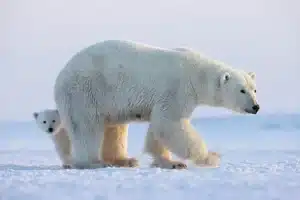
Ursus Maritimus Marinus
Polar bears, scientifically known as Ursus maritimus maritimus, are magnificent creatures that call the Arctic home. As one of the
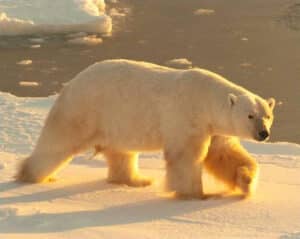
Ursus Maritimus Maritimus
The polar bear (Ursus maritimus maritimus) is not only the largest bear species but also one of the most iconic

Ursus Maritimus Tyrannus
The Ursus Maritimus Tyrannus, or the “tyrant polar bear,” is an extinct subspecies of polar bear that roamed the earth
